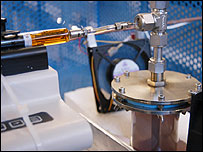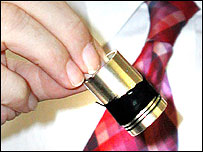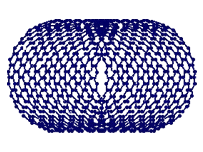July 21, 2004
Old Leatherwings
There's a short story in the new Lenox Avenue ezine called "Old Leatherwings". I'm not sure I really got it, so I'd be interested in hearing what some of the rest of you make of it.
July 17, 2004
The Cusp
You know what being on the cusp is, right? It's a perch on the moment, an almost endless interval before the moment occurs but close enough to see it coming.
I'm on the cusp of a move. I've spent 2 years north of the Mason-Dixon line, a place I was probably never meant to be. The duration is just about over, now, as I prepare to head back to another place where I was probably never meant to be but at least at the right latitude.
Changes in latitude, changes in attitude ... it's not just a song.
I've watched the light change as the year progresses, which I never really noticed before. I've driven through vast empty fields where nothing blocks the wind, and the wind makes it's presence felt. I've trod carefully over ice-covered streets and sidewalks, never quite slipping but coming close enough to taste real fear of a broken bone.
I've had some of the worst nights of my life, but they weren't associated with this place necessarily and they are in the past.
I will end up back in a sun-drenched valley where so many things started and nothing seemed like home. I have a bit of a drive to get there, but drives aren't the problem for me that once they were. I'll have another den to slip into, though for the first time the new den will have a washer and dryer. I'll even have easy access to a racquetball court, which hasn't been true since college.
Some good things happened there. I have to remember that.
Pretty soon I'll be past the cusp, following the sun's daily path and winter-to-summer path. The moment will have passed, and a new moment will be waiting somewhere. Nothing like life, hmm?
July 14, 2004
Hawking cracks black hole paradox
I'm not sure it counts as "cracking a paradox", if the person doing so is the same person who suggested the paradox in the first place...still, it's always nice to see science outweigh ego. ;-)
After nearly 30 years of arguing that a black hole destroys everything that falls into it, Stephen Hawking is saying he was wrong. It seems that black holes may after all allow information within them to escape. Hawking will present his latest finding at a conference in Ireland next week.
The about-turn might cost Hawking, a physicist at the University of Cambridge, an encyclopaedia because of a bet he made in 1997. More importantly, it might solve one of the long-standing puzzles in modern physics, known as the black hole information paradox.
It was Hawking's own work that created the paradox. In 1976, he calculated that once a black hole forms, it starts losing mass by radiating energy. This "Hawking radiation" contains no information about the matter inside the black hole and once the black hole evaporates, all information is lost.
But this conflicts with the laws of quantum physics, which say that such information can never be completely wiped out. Hawking's argument was that the intense gravitational fields of black holes somehow unravel the laws of quantum physics.
Other physicists have tried to chip away at this paradox. Earlier in 2004, Samir Mathur of Ohio State University in Columbus and his colleagues showed that if a black hole is modelled according to string theory - in which the universe is made of tiny, vibrating strings rather than point-like particles - then the black hole becomes a giant tangle of strings. And the Hawking radiation emitted by this "fuzzball" does contain information about the insides of a black hole (New Scientist print edition, 13 March).
Now, it seems that Hawking too has an answer to the conundrum and the physics community is abuzz with the news. Hawking requested at the last minute that he be allowed to present his findings at the 17th International Conference on General Relativity and Gravitation in Dublin, Ireland.
"He sent a note saying 'I have solved the black hole information paradox and I want to talk about it'," says Curt Cutler, a physicist at the Albert Einstein Institute in Golm, Germany, who is chairing the conference's scientific committee. "I haven't seen a preprint [of the paper]. To be quite honest, I went on Hawking's reputation."
Though Hawking has not yet revealed the detailed maths behind his finding, sketchy details have emerged from a seminar Hawking gave at Cambridge. According to Cambridge colleague Gary Gibbons, an expert on the physics of black holes who was at the seminar, Hawking's black holes, unlike classic black holes, do not have a well-defined event horizon that hides everything within them from the outside world.
In essence, his new black holes now never quite become the kind that gobble up everything. Instead, they keep emitting radiation for a long time, and eventually open up to reveal the information within. "It's possible that what he presented in the seminar is a solution," says Gibbons. "But I think you have to say the jury is still out."
At the conference, Hawking will have an hour on 21 July to make his case. If he succeeds, then, ironically, he will lose a bet that he and theoretical physicist Kip Thorne of the California Institute of Technology (Caltech) in Pasadena made with John Preskill, also of Caltech.
They argued that "information swallowed by a black hole is forever hidden, and can never be revealed".
"Since Stephen has changed his view and now believes that black holes do not destroy information, I expect him [and Kip] to concede the bet," Preskill told New Scientist. The duo are expected to present Preskill with an encyclopaedia of his choice "from which information can be recovered at will".
Hello, I'm on the train...
Dang, and here I was hoping for a few moments of peace and quiet, sans ringtones. (What if the two parties were on separate trains, headed in opposite directions? Would the speed requirement be halved?)
Question
How fast must a train be travelling for the Doppler effect to put all the mobile phones being used on it out of action?
- Philip Woodward , Malvern, Worcestershire, UK
Answer
The Doppler effect says that if an object emitting a wave is approaching the receiver of the wave, it is heard at a higher frequency by the following factor:
frequency heard = frequency sent x (1/(1-speed/c))
where c is the speed of your wave (practically the speed of light in this case).
If the emitter is moving away from your receiver, its frequency is lowered by the following factor:
frequency heard = frequency sent x (1/(1+speed/c))
In the UK, mobile phones use either the GSM900 protocol, broadcasting in the 890-915 megahertz range for uplinks and 935-960 MHz for downlinks, or the GSM1800 protocol, with equivalent ranges of 1710-1785 MHz and 1805-1880 MHz.
To ensure that one end of each of these ranges is Dopplered out the other end, one would need to travel at a speed of roughly 3 per cent of the speed of light for GSM900 signals, or 4 per cent for GSM1800. This amounts to a train speed of between 32 million and 43 million kilometres per hour.
Somehow I don't think that's likely on UK trains. Or indeed any others, if I'm being reasonable.
- Simon Scarle , University of Manchester Institute of Science and Technology, UK
July 08, 2004
Nanotubes again
The Beeb has another story (full text here or below) related to our past discussions re: tethered satellites and space elevators. The illustrations are pretty interesting, from a lay perspective:



Nano-team spins tomorrow's yarn
By Jo Twist
BBC News Online science and technology staff
A method to continuously spin a wonder material, which is worth more per kg than gold, has been developed by Cambridge-MIT Institute scientists.
Discovered in 1991, carbon nanotubes are just a few billionths of a metre across, but are ultra-strong.
They have been spun before, but directly spinning them into a fibre as they are made has proven very difficult.
The Cambridge way brings the industrial production of a myriad of materials made of carbon nanotubes a step closer.
The technique has been developed in the last six months by a UK team led by Professor Alan Windle at the Cambridge-MIT Institute (CMI).
"Carbon nanotubes are very, very interesting structures with quite amazing potential. They represent one aspect of nanotechnology," he told BBC News Online.
"Now, suddenly, one can relate this thing called a nanotube into something people can see."
The spinning process happens in furnace equipment which has been specially built at Cambridge University's Department of Materials Science and Metallurgy.
"We wanted to organise the nanotubes in parallel to make a fibre," explained Professor Windle.
"So we came up with a process that makes fibre continuously from a reaction zone."
In very simple terms, the process is rather reminiscent of a candy floss machine, in which a black fluffy cloud is created then spun on to a spindle as a thread.
The nanotubes are created rapidly by squirting a carbon source, like ethanol, and an iron nanocatalyst through a hydrogen carrier, and into a furnace at 1,200 degrees Celsius.
A fine black "elastic smoke", called an aerogel, then forms using the iron in ferrocene as a catalyst, and starts to stick to the cooler wall in the furnace to form fibres.
A spindle then winds the aerogel fibres into a thread, at several centimetres per second.
The result is an extremely fine and strange black thread that is about as strong as clothes fibre, and can carry an electrical current.
Professor Windle and his team aim to improve that strength 10-fold in the next year or so, but they need to learn more about how to organise the nanotubes before strength can be improved.
The problem with nanotubes is that they have been tricky to organise; and to harness their potential use on a large scale, cheap and quick ways of processing them are required.
Nanotube fibres in the form of ribbons were processed by a French team from the Paul Pascal Research Centre, at the University of Bordeaux, in 2000.
But, said Professor Windle, pervious efforts at turning nanotubes into continuous fibres could only be done after they were made, through post-processing methods.
His method means they are made and spun in the same process.
Carbon nanotubes are essentially sheets of graphite, an atom deep, which have folded back on themselves.
They were discovered soon after a spherical cage of carbon atoms, called a buckminsterfullerene - nicknamed a buckyball - was found.
Their discovery excited scientists all over the world because nanotubes are very rigid structures which are as stiff as diamonds along their axes.
They could potentially prove to be stronger than steel.
Space enthusiasts are keen to monitor developments in nanotube technology too because many see them as a way of making viable "space elevator" and tethered satellite technologies.
In theory, Professor Windle explained, a satellite could be "tied" to Earth with a cable, but it has to be light and very strong, hence the excitement around carbon nanotubes.
"If one can make a fibre that strong and that stiff, it would have a myriad of uses," explained Professor Windle.
"It is potentially a strong, cheap, light fibre which will very much enable materials."
Composite materials could be produced containing a high percentage of the fibre, which could be used to coat other materials or surfaces.
This could be very useful in areas of space, molecular electronics, motorcar, and military industries.
Carbon nanotubes could become a key part of creating memory for quantum computers, for instance. Or their commercial success could lie in the less hi-tech industries, said Professor Windle.
The fibres could be woven into strong, light, flexible and conductive textiles. But there is still a long way to go until real use is made of them.
"We have 10 years of very exciting material science here," he said. "But as with so many things, we have done the technology first, and now we have see what happens with it."
July 06, 2004
Dangerous Pattern
This picture isn't retouched; I really did see this particular cloud formation pass by my apartment one fine day. Yes, there were tornadoes in the area at the same time, but thankfully not from this particular mass.

Hollywood's got a lot to learn from the original master of special effects.
Edge of Desolation
Since the current theme seems to be pictures, I thought I'd offer this view of the Badlands in South Dakota.

Man has certainly been responsible for terrible erosion damage as a result of careless landscape treatment, but Nature has done its bit from time to time as well. This particular process started a long time before the talking bipeds found North America.